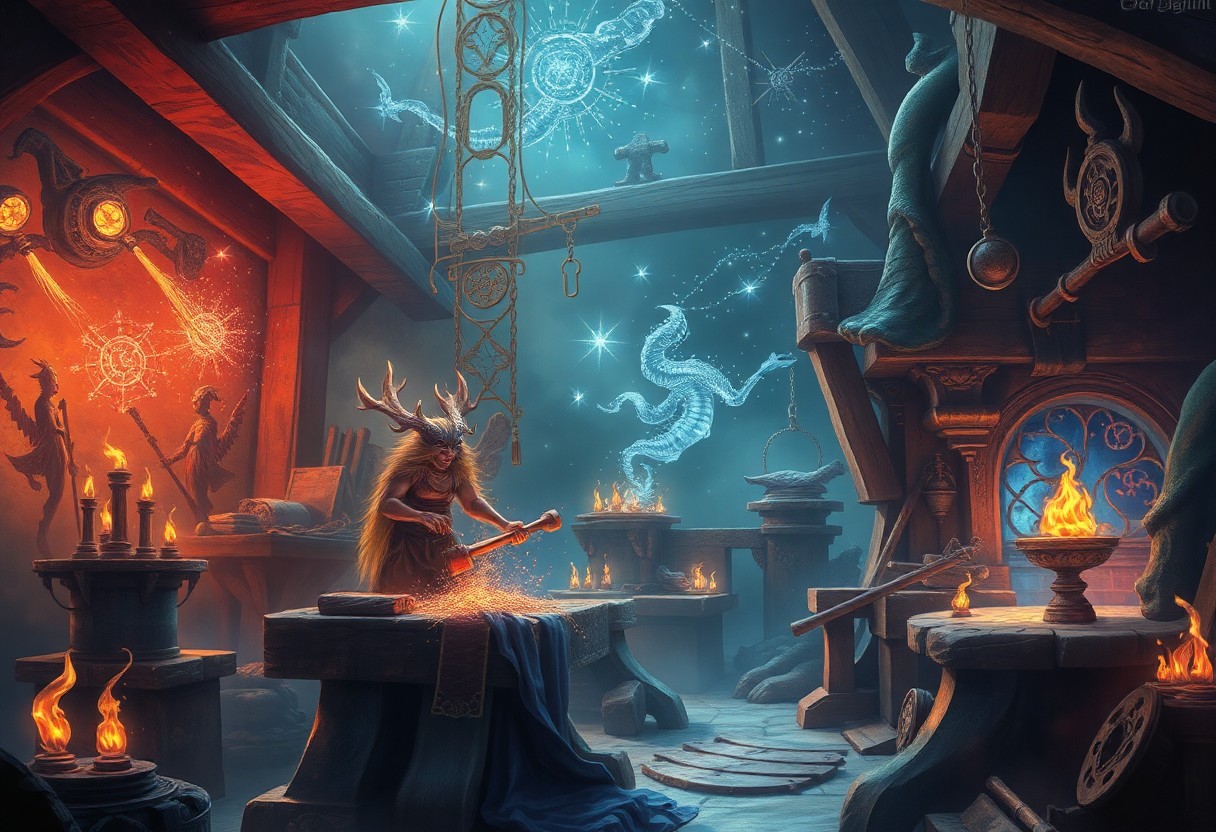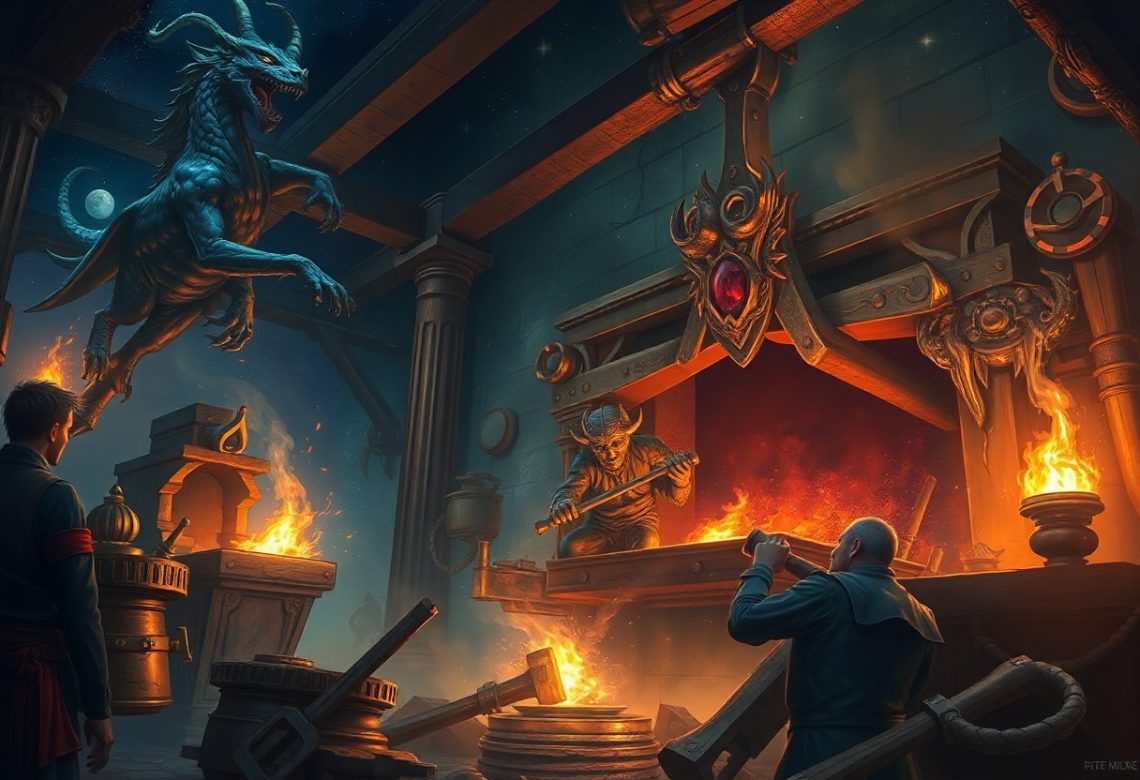It’s crucial to explore the remarkable figure of Svaroh, the celestial blacksmith revered in various mythologies as the divine craftsman of the gods. You will discover how his unparalleled skills shaped the heavens, forging legendary weapons and artifacts that empowered deities and heroes alike. Through this post, you will gain insight into Svaroh’s significance in mythology, his legendary creations, and the enduring legacy he has left across cultures. Prepare to explore into the fascinating world of this celestial artisan and the artistry that elevated the divine realm.

The Mythological Origins of Svaroh
As you explore the mythological origins of Svaroh, you will uncover a rich tapestry of tales that weave together the birth of this divine blacksmith. Svaroh is often depicted as a powerful figure among the celestial beings, embodying the forces that shape and forge the world around us. His legacy dates back to ancient Slavic traditions, where he is revered not only for his craftsmanship but also for his connection to the cosmos and the elements that govern creation itself.
Svaroh in Slavic Cosmology
After entering into Slavic cosmology, you will find that Svaroh occupies a significant position as a celestial artisan, akin to Hephaestus from Greco-Roman traditions. His role embodies the unity of fire, earth, and air, representing the interconnectedness of all things in the universe. Svaroh’s influence can be seen in the natural order, where he provides guidance in the arts of metalworking and the wisdom of crafting tools necessary for survival.
The Role of Svaroh in Creation Myths
Between the various Slavic creation myths, Svaroh is often portrayed as a primordial force that shapes the very fabric of existence. From forging the heavens to tempering the earth, his craftsmanship brings life and balance to the world. With his divine hammer, he births celestial bodies, creating stars that shine in the night sky, while also bestowing humanity with vital resources through the alchemy of nature.
This aspect of Svaroh’s role highlights the importance of his character in Slavic folklore, where he is not merely a forger of metal, but a powerful architect of life. Through his creations, you will discover how he instilled harmony and order, shaping not only the physical world but also the spiritual essence that resonates within human culture. Understanding Svaroh allows you to appreciate the deeper connections between craftsmanship, creativity, and the cosmos in Slavic mythology.

The Craftsmanship of Svaroh
It is within the flames of his forge that Svaroh transforms raw materials into divine masterpieces. Revered as the celestial blacksmith of the gods, your understanding of Svaroh’s craftsmanship reveals his unparalleled ability to blend beauty with utility. His techniques showcase not only skill but also a deep connection to the elemental forces of creation. From weapons to artifacts, each item carries the essence of its maker, inspiring reverence and respect among deities and mortals alike.
Symbolism of Fire and Forging
For Svaroh, fire is both a tool and a symbol, representing transformation and renewal. The act of forging signifies the harnessing of chaotic energy, shaping it into purpose and form. You can see this duality in the powerful flames that dance within his forge, embodying the relentless drive of creativity. Just as fire can destroy, it also grants life to new creations, echoing the cycle of birth and rebirth in the universe.
Artifacts Created by Svaroh
Symbolism is deeply embedded in the artifacts created by Svaroh, each piece a manifestation of divine intent. His creations, from legendary swords to ornate crowns, are imbued with magical properties and cultural significance, serving not just as tools but as emblems of power and status. You can appreciate the artistry and meticulous crafting that has gone into each item, designed to uphold the virtues and values of the gods themselves.
Hence, you will find that these artifacts serve multiple roles beyond mere function; they are symbols of divine intervention in human affairs. Each piece carries stories and lore, resonating with the energy of Svaroh himself. By understanding each artifact’s origins and symbolism, you connect deeply with the mythology surrounding Svaroh, enriching your appreciation for the celestial craft that shapes and influences the realms of both gods and mortals.

Svaroh’s Influence on Other Deities
If you explore into mythology, you’ll find that Svaroh, the Celestial Blacksmith, has significantly shaped the abilities and identities of numerous deities. His mastery over creation fostered not only craftsmanship but also enlightenment across the pantheon. Other gods turned to Svaroh for guidance and inspiration, leading to a harmonious exchange of ideas that elevated divine craftsmanship and artistry in the heavens.
Connections with Other Gods
Before exploring the intertwining relations among deities, keep in mind that Svaroh’s influence extended well beyond his forge. He shared deep connections with gods such as Vishnu and Narasimha, training them in the arts of crafting powerful weapons and artifacts. This collaboration elevated their divine statuses, bolstering their roles within their respective mythologies.
Legacy and Worship Practices
Gods often sought to honor Svaroh through various rituals, recognizing his pivotal role in their pantheons. Worship practices dedicated to him include offerings of crafted metalworks and prayers invoking his guidance in artistry and creation.
Legacy extends beyond mere creations; it embodies the essence of divine art and skill that Svaroh instilled in worshippers. You may find that followers engage in practices that emphasize craftsmanship, seeking to mirror Svaroh’s dedication to their own crafts. Festivals celebrating his contributions involve the crafting of intricate pieces, with prayers offered for skill and inspiration, ensuring that the legacy of the Celestial Blacksmith lives on in both the heavens and human endeavors.
Svaroh in Modern Culture
Many contemporary artists and writers draw inspiration from Svaroh, the celestial blacksmith, weaving his tales into their works. You can often find references to Svaroh in various forms of media, illustrating the enduring relevance of Slavic mythology. His craftsmanship not only symbolizes creation and strength but also serves as a reminder of the rich cultural heritage awaiting rediscovery in your own explorations of myth and legend.
Representations in Literature and Art
Along the pages of modern literature and the canvas of contemporary art, Svaroh manifests in diverse interpretations. You may notice him depicted as a symbol of resilience or depicted in vivid imagery that captures the essence of creation and divine craftsmanship. These representations not only engage the imagination but also invite you to explore deeper into the meanings behind the stories surrounding this legendary figure.
The Revival of Slavic Mythology
Mythology is experiencing a resurgence, with a growing interest in Slavic narratives, including Svaroh’s rich legacy. You may find this revival reflected in various artistic expressions, such as literature, film, and even music, as creators explore these ancient tales anew. This revival connects you to a broader cultural movement that values and celebrates your roots while showcasing the relevance of these myths in today’s world.
But this revival goes beyond mere interest; it serves as a bridge to your cultural identity. The rediscovery of Svaroh and other Slavic deities allows you to reconnect with your heritage, fostering a sense of belonging in a contemporary context. As more people engage with these myths, you can participate in a global conversation that honors ancient wisdom while adapting it to your modern experiences, enriching your understanding of self and culture.
Comparative Analysis with Other Mythological Blacksmiths
Keep exploring the fascinating world of mythological blacksmiths, as Svaroh stands out among them. Below is a comparative analysis of Svaroh and other renowned blacksmiths in mythology.
| Blacksmith | Cultural Context |
|---|---|
| Svaroh | Slavic Mythology |
| Hephaestus | Greek Mythology |
| Wayland the Smith | Norse Mythology |
Hephaestus in Greek Mythology
Above all, Hephaestus is renowned as the Greek god of fire and craftsmanship, symbolizing innovation and creativity. He creates magnificent weapons and armor for the gods, illustrating the vital link between divine power and artistic skill.
Wayland the Smith in Norse Mythology
Behind the tales of Norse mythology, Wayland the Smith emerges as a legendary figure, revered for his unparalleled skills in metalwork and craftsmanship. His stories often revolve around themes of vengeance and resilience, highlighting the complexity of his character.
At the heart of Norse legends, Wayland’s narrative reveals a wealth of symbolism, including themes of craftsmanship and betrayal. He is said to have created extraordinary items, like the sword of Sigurd, showcasing not only his smithy talents but also his cunning nature. Your understanding of Wayland will deepen as you explore how his myth intertwines with concepts of fate and justice, enriching the very fabric of Norse mythology.
Conclusion
With this in mind, you can appreciate how Svaroh, the Celestial Blacksmith of the Gods, embodies the intricate balance of creation and destruction in mythological narratives. His role not only highlights the importance of craftsmanship in divine realms but also serves as a reminder of your own capacity for innovation and transformation. As you reflect on these stories, consider how the principles of creation and enhancement resonate with your own life and aspirations.





